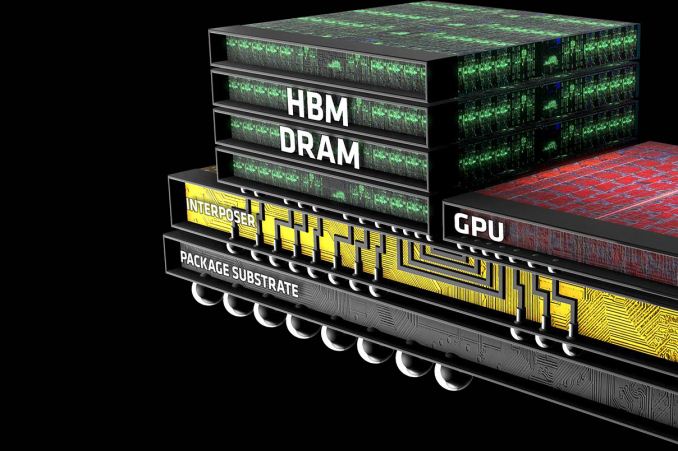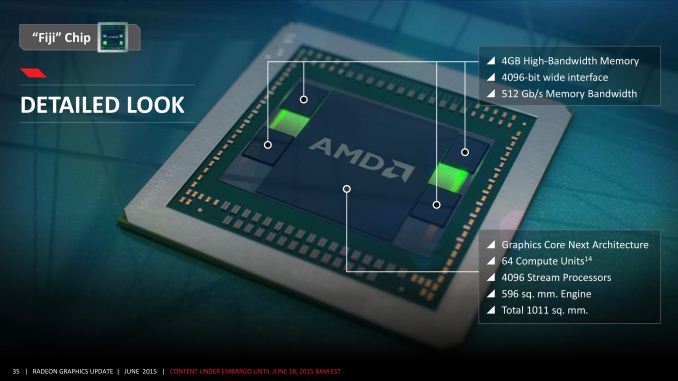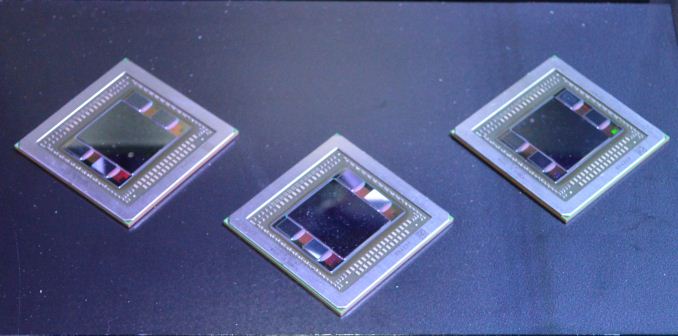The AMD Radeon R9 Fury X Review: Aiming For the Top
by Ryan Smith on July 2, 2015 11:15 AM ESTThe Fiji GPU: Go Big or Go Home
Now that we’ve had a chance to take a look at the architecture backing Fiji, let’s talk about the Fiji GPU itself.
Fiji’s inclusion of High Bandwidth Memory (HBM) technology complicates the picture somewhat when talking about GPUs. Whereas past GPUs were defined by the GPU die itself and then the organic substrate package it sits on, the inclusion of HBM requires a third layer, the silicon interposer. The job of the interposer is to sit between the package and the GPU, serving as the layer that connects the on-package HBM memory stacks with the GPU. Essentially a very large chip without any expensive logic on it, the silicon interposer allows for finer, denser signal routing than organic packaging is capable of, making the ultra-wide 4096-bit HBM bus viable for the first time.
We’ll get to HBM in detail in a bit, but it’s important to call out the impact of HBM and the interposer early, since they have a distinct impact on how Fiji was designed and what its capabilities are.
As for Fiji itself, Fiji is unlike any GPU built before by AMD, and not only due to the use of HBM. More than anything else, it’s simply huge, 596mm2 to be precise. As we mentioned in our introduction, AMD has traditionally shied away from big chips, even after the “small die” era ended, and for good reason. Big chips are expensive to develop, expensive to produce, take longer to develop, and yield worse than small chips (this being especially the case early-on for 40nm). Altogether they’re riskier than smaller chips, and while there are times where they are necessary, AMD has never reached this point until now.
The end result is that for the first time since the unified shader era began, AMD has gone toe-to-toe with NVIDIA on die size. Fiji’s 596mm2 die size is just 5mm2 (<1%) smaller than NVIDIA’s GM200, and more notably still hits TSMC’s 28nm reticle limit. TSMC can’t build chips any bigger than this; Fiji is as big a chip as AMD can order.
| AMD Big GPUs | ||||
| Die Size | Native FP64 Rate | |||
| Fiji (GCN 1.2) | 596mm2 | 1/16 | ||
| Hawaii (GCN 1.1) | 438mm2 | 1/2 | ||
| Tahiti (GCN 1.0) | 352mm2 | 1/4 | ||
| Cayman (VLIW4) | 389mm2 | 1/4 | ||
| Cypress (VLIW5) | 334mm2 | 1/5 | ||
| RV790 (VLIW5) | 282mm2 | N/A | ||
Looking at Fiji relative to AMD’s other big GPUs, it becomes very clear very quickly just how significant this change is for AMD. When Hawaii was released in 2013 at 438mm2, it was already AMD’s biggest GPU ever for its time. And yet Fiji dwarfs it, coming in at 158mm2 (36%) larger. The fact that Fiji comes at the latter-half of the 28nm process’s life time means that such a large GPU is not nearly as risky now as it would have been in 2011/2012 (NVIDIA surely took some licks internally on GK110), but still, nothing else we can show you today can really sell the significance of Fiji to AMD as much as the die size can.
And the fun doesn’t stop there. Along with producing the biggest die they could, AMD has also more or less gone the direction of NVIDIA and Maxwell in the case of Fiji, building what is unambiguously the most gaming/FP32-centric GPU the company could build. With GCN supporting power-of-two FP64 rates between 1/2 and 1/16, AMD has gone for the bare minimum in FP64 performance that their architecture allows, leading to a 1/16 FP64 rate on Fiji. This is a significant departure from Hawaii, which implemented native support for ½ rate, and on consumer parts offered a handicapped 1/8 rate. Fiji will not be a FP64 powerhouse – its 4GB of VRAM is already perhaps too large of a handicap for the HPC market – so instead we get AMD’s best FP32 GPU going against NVIDIA’s best FP32 GPU.
AMD’s final ace up their sleeve on die size is HBM. Along with HBM’s bandwidth and power benefits, HBM is also much simpler to implement, requiring less GPU space for PHYs than GDDR5 does. This is in part due to the fact that HBM stacks have their own logic layer, distributing some of the logic on to each stack, and furthermore a benefit of the fact that the signaling logic that remains doesn’t have to be nearly as complex since the frequencies are so much lower. 4096-bits of HBM PHYs still takes up a fair bit of space – though AMD won’t tell us how much – but it’s notably lower than the amount of space AMD was losing to Hawaii’s GDDR5 memory controllers.
The end result is that not only has AMD built their biggest GPU ever, but they have done virtually everything they can to maximize the amount of die space they get to allocate to FP32 and rendering resources. Simply put, AMD has never reached so high and aimed for parity with NVIDIA in this manner.
Ultimately this puts Fiji’s transistor count at 8.9 billion transistors, even more than the 8 billion transistors found in NVIDIA’s GM200, and, as expected, significantly more than Hawaii’s 6.2 billion. Interestingly enough, on a relative basis this is almost exactly the same increase we saw with Hawaii; Fiji packs in 43.5% more transistors than Hawaii, and Hawaii packed in 43.9% more transistors than Tahiti. So going by transistors alone, Fiji is very much to Hawaii what Hawaii was to Tahiti.
Finally, as large as the Fiji GPU is, the silicon interposer it sits on is even larger. The interposer measures 1011mm2, nearly twice the size of Fiji. Since Fiji and its HBM stacks need to fit on top of it, the interposer must be very large to do its job, and in the process it pushes its own limits. The actual interposer die is believed to exceed the reticle limit of the 65nm process AMD is using to have it built, and as a result the interposer is carefully constructed so that only the areas that need connectivity receive metal layers. This allows AMD to put down such a large interposer without actually needing a fab capable of reaching such a large reticle limit.
What’s interesting from a design perspective is that the interposer and everything on it is essentially the heart and soul of the GPU. There is plenty of power regulation circuitry on the organic package and even more on the board itself, but within the 1011mm2 floorplan of the interposer, all of Fiji’s logic and memory is located. By mobile standards it’s very nearly an SoC in and of itself; it needs little more than external power and I/O to operate.













458 Comments
View All Comments
chizow - Friday, July 3, 2015 - link
Its possible, WCE Fury was rumored even last year I believe, so I don't think it was a last ditch effort by AMD. I do think however, it was meant to challenge Titan, especially with the new premium branding and it just fell way short of not only Titan X, but also 980Ti.I do fully agree though they've basically eaten up their entire OC headroom in a full on attempt to beat 980Ti, and they still didn't make it. Keep in mind we're dealing with a 275W rated part with the benefit of no additional leakage from temperature. The 275W rated air cooled version is no doubt going to be clocked slower and/or have functional units disabled as it won't benefit from lower leakage from operating temps.
I think the delayed/staggered approach to launch is because they are still binning and finalizing the specs of every chip, Fury X is easy, full ASIC, but after that they're having a harder time filling or determining the specs on the Nano and Air Fury. Meanwhile, Nvidia has had months to stockpile not only Titan X chips, but anything that was cut down for the 980Ti and we've seen much better stock levels despite strong sell outs on the marketplace.
silverblue - Thursday, July 2, 2015 - link
It's very difficult to find, but I've managed to locate one here in the UK from CCL Online... a PowerColor model (AX R9 FURY X 4GBHBM-DH) for £550. Shame about the price, though it isn't any more expensive than the 980 Ti.mapesdhs - Friday, July 3, 2015 - link
In which case I'd get the 980 Ti every time. Less hassle & issues all round. Think ahead for adding a 2nd card, the build issues with a 980 Ti are nill.deathBOB - Thursday, July 2, 2015 - link
Despite losing to the 980ti, I still think this card offers a good value proposition. I would gladly give up a small amount of performance for better acoustics and more flexible packaging with the CLC (assuming AMD fixes the noise issue other sites are reporting).silverblue - Thursday, July 2, 2015 - link
I never thought I'd say this, but drivers have to be causing some of the issues.Fury X isn't such a bad deal; the quality of the product along with noise and temperatures (or the lack of them) can land it in smaller cases than the 980Ti. I do have to wonder why it performs comparatively better at 4K than at 1440p (I've seen weird regressions at 720p in the past), and why delta compression isn't helping as much as I expected. Overclockers may even find Fury (air-cooled) to be faster.
tviceman - Thursday, July 2, 2015 - link
If you overclock at all, it's not small performance you'd be giving up. The 980 TI regularly gets a 20% performance gain from OCing, while Fury X is currently only getting 5-7%. At 1440p, you're looking at a 25% performance difference.looncraz - Thursday, July 2, 2015 - link
We don't know Fury X's full overclocking abilities yet, no one has unlocked the voltage. It might take a bios mod (shame on you AMD for locking the voltage at all, though!), but it will happen, and then we'll get an idea of what can be done.chizow - Thursday, July 2, 2015 - link
Or more likely, AMD already "overclocked" and squeezed every last drop but 5-10% out of Fury X in a full on attempt to match 980Ti, and they still didn't make it.andychow - Friday, July 3, 2015 - link
This makes no sense at all. AMD clearly claimed you could overclock this, but they lock the voltage? The only explanation is that the chip is already clocked at the highest level. I never believed I would agree with that troll chizow, but here we are.chizow - Friday, July 3, 2015 - link
Haha well, maybe you should go back and read some of those "troll" posts and see who was trolling whom. ;)